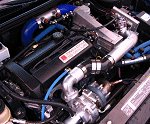

|
Street Class Unlimited Class
DOHC SOHC Ion Updated 1/05 For the most recent list of the fastest five cars click here. |
Fuel System Solutionsby:TitanWhen I decided to turbo my car there were several things I had to take into consideration one of which was the fueling system. People have tried many different methods of adding extra fuel on their turbo cars with varying luck. So, being the information junkie I am I researched all the options available. I then tracked down the people that have used these systems and asked what they thought of them. Below are several of the methods that I considered before I settled on my solution. I'm not saying that any of the methods below are right or wrong, I'm saying that they didn't fit my needs. Remember that all of the fuel systems below have worked in the past for people. I strongly encourage you to weight all your options and find your best fit. The easiest and most basic method for adding fuel is to use the stock injectors (19lbs) and raise the fuel pressure with an RRFMU. Unfortunately, this method tends to raise the fuel pressure well above 60psi, which creates an unreliable system. One of the main goals in building any fuel system must be reliability and locking the injectors under excessive fuel pressure was something I couldn't risk on a daily driver. So, I scratched this option off the list. Next, I considered the sds system. I tracked down several people who had used this system on their cars and inundated them with questions. I quickly found out that although the sds system provides ample fuel for the car under boost, adjusting the fuel delivery to match the required fuel curve was somewhat difficult. Most people commented on their car's drivability issues indicating that their cars ran well at WOT but the mid range was boggy and fuel was often delivered in excess even with tuning. Granted, the extra fuel would save the engine from running lean but the cost of the unit, the drivability issues, and all the work of installing extra injectors into the manifold just didn't seem like a good solution to me. I crossed this off the list and moved on. Apex'i makes a fuel solution called the super AFC fuel computer. This piggyback computer allows you to richen or lean your air/fuel mixture by 50% over 8 points every 500rpm. In theory this is a good setup but with only 8-points of adjustment +/- 50% this solution is limited. It would be a nice setup for low boost applications but limited if you ever wanted to crank up the boost on a forged engine. Personally, I'm not interested in having a lot of gauges in my car and this is just one more to find a place for. Cost, limited boost application, and one more gauge to find a home for tossed this option out of the pool. The E-manage is supposed to control both the fuel and ignition. Unfortunately, the E-mange has a difficult time consistantly adjusting the injector pulse width. This makes the car run rich most of the time killing the engine's power. The timing part of E-manage does work but if you're paying for two options shouldn't they both work? Save your money and move on to another option. A relatively new trick has been to put a 2 or 3 bar map sensor on the car with larger injectors. On paper this fix has potential but Saturn's advanced timing quickly becomes an issue. I'll explain how this works. All map sensors read from 0-5volts. Compared to a 1 bar map sensor a 2 bar map sensor cuts the voltage signal in half. This means that at WOT the 1 bar map sensor is registering 5 volts while the 2 bar registers 2.45 volts. By replacing the cars map sensor to a 2 bar you could double the current injector size. Doubling the injector size and map sensor at the same time would effectively trick the ECU into thinking that nothing was wrong. Sounds great right? The jury is still out on this one being a viable solution. Many people have commented on stand alone engine management systems. While these are the ultimate solution for racecars their price and tuning/installation difficulty puts it well out of the reach of most enthusiasts. I don't believe that a stand alone engine management system is the way to go. Easier solutions can be had for a fraction of the cost. The saying, "it's all in the tuning" holds very true. You better have a lot of cash to make this option work properly on a daily driver. Weather and altitude changes can quickly turn a perfectly tuned car into an under performing waste of money. Just remember that next time someone spouts off "buy a stand alone".
Apex'i Super AFC 2 Mega Squirt (my pick) Cracked OBD-1 code After reviewing all of the methods above I decided to pick the most reliable and easiest methods and combine them into one. I decided that I would limit boost to no more than 5psi with this in mind I could spend relatively little and still have a reliable system. I started my system with a cost effective 6:1 RRFMU. I didn't want to fall into the trap of excessive fuel pressures that I saw some people were running so I limited myself to a maximum of 60psi and worked backwards. Using the information found in Fred's article understanding fuel injectors I began crunching numbers. I found that if I installed a 24lb injector, reduced my fuel pressure to 30lb, and boosted 5psi I would hit 60psi. At 30lbs of fuel pressure my 24lb injectors would be reduced to 20lb injectors. I figured that the computer could compensate from there but I was wrong. Shortly after installing my injectors and turning down the fuel pressure my car threw a check engine code. It was running too rich and I was experiencing drivability problems. The car didn't want to rev past 5,000rpm it would literally fall on its face forcing me to short shift. I thought that the stock airfilter was too restrictive choking off the airflow. So, I immediately replaced the stock filter with a K&N filter and had the code erased. Everything was fine until until15 minutes later when he code reappeared. Now I was becoming frustrated. I went back and recalculated my injector numbers but they were all correct. It was now time to trouble shoot. I pulled the car into the garage, put the fuel pressure gauge back on the car, and started it up. It was still reading 30psi of fuel pressure just like before so I reved the engine a few times to check if it was returning to 30psi. Interestingly while I reved the car I noticed that the fuel pressure increased 5-6 pounds right off idle. I hadn't taken that into consideration when doing my calculations. I turned down the fuel pressure even more till it read 24lbs of pressure at idle. Initially I was concerned about the injector spray pattern at such a low fuel pressure but as soon as I started reving the engine the pressure immediately jumped to 30psi. Right where I wanted it to be. I jumped back into the car and setout to have the codes erased. I quickly noticed that the car was running a lot better than it had been since I started my fuel system. I was now able to rev the engine all the way up to 6,000rpm. I have not seen the code since it was erased that last time. I thought it would be helpful includng my experience with my fuel system. Just remember it's never as easy as it seems. |
|



